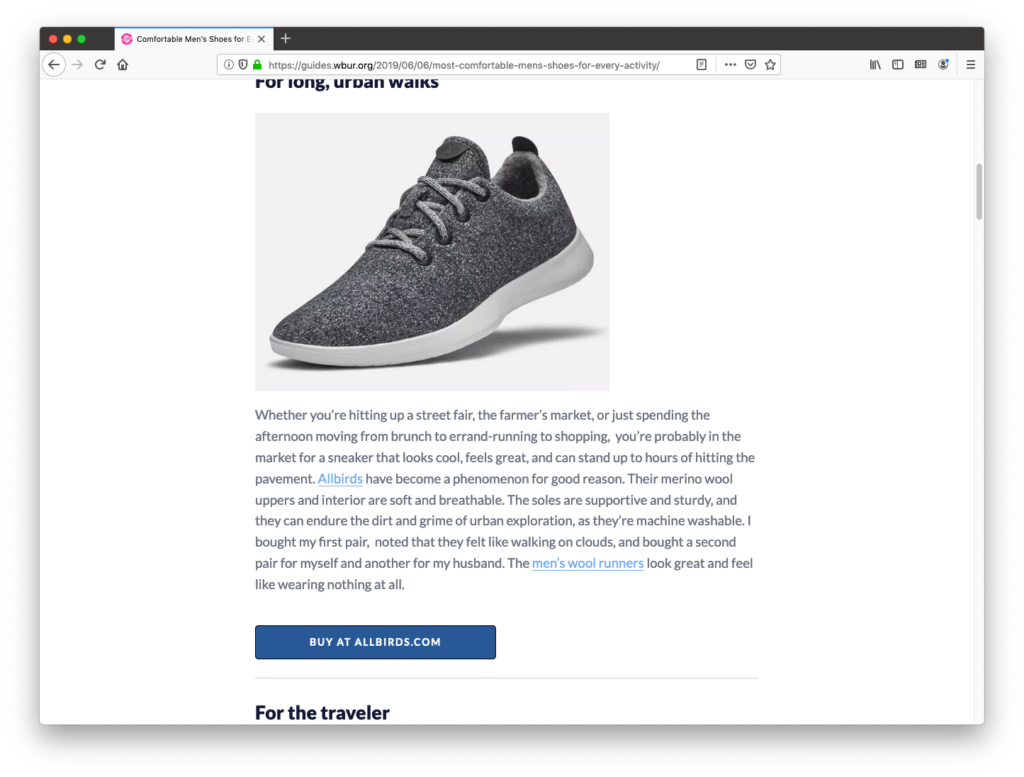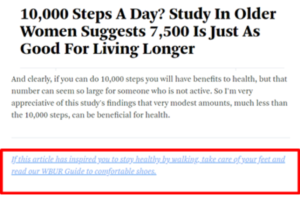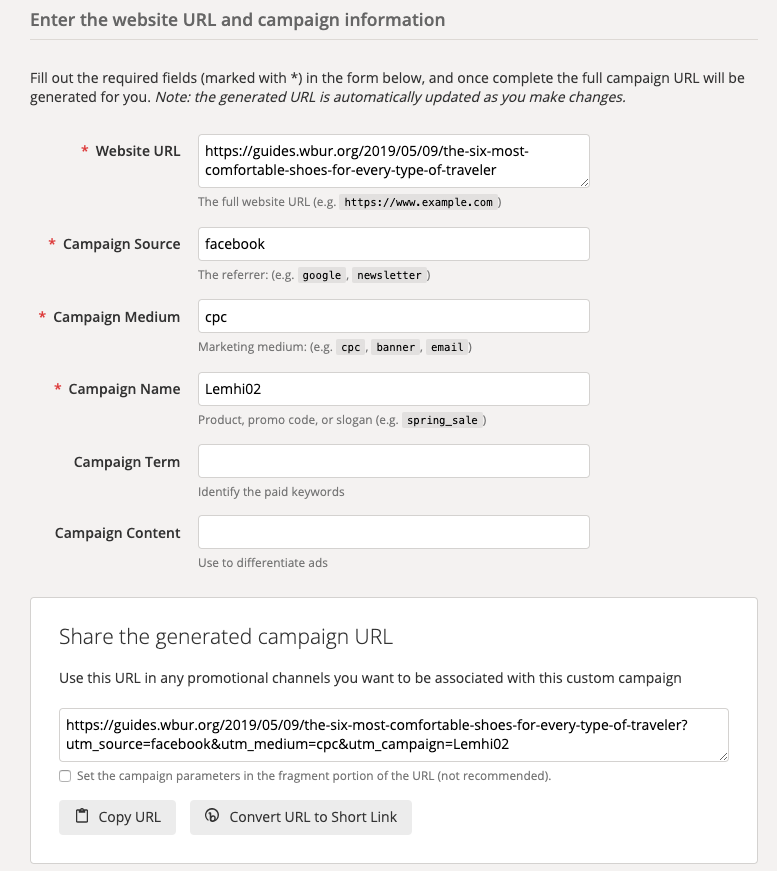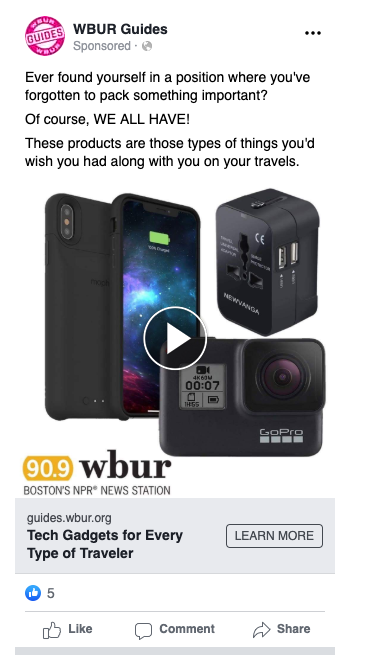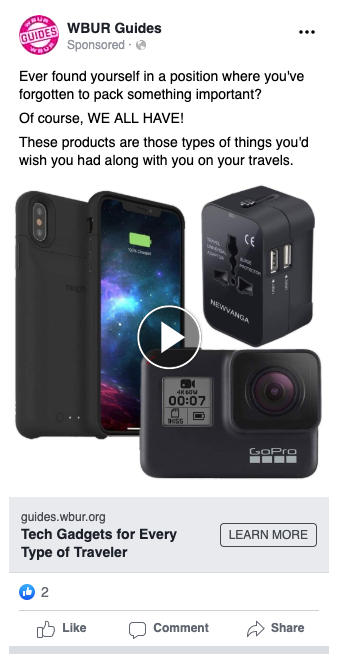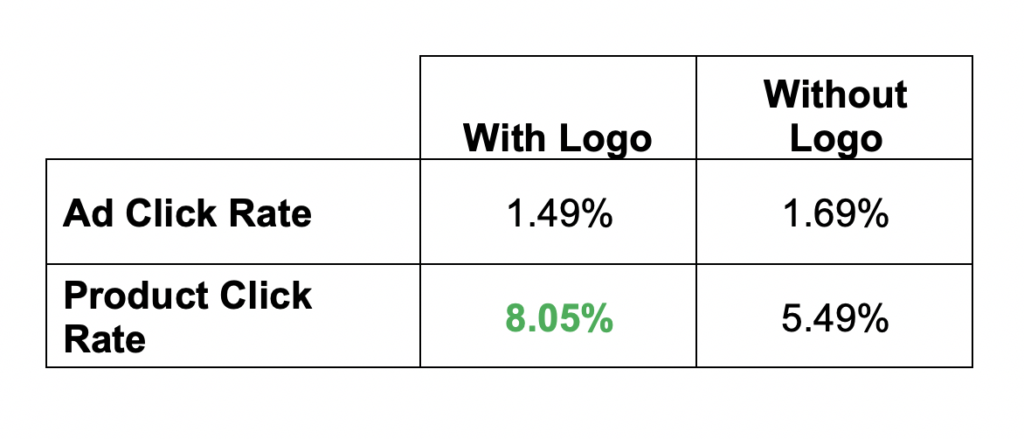[This is Part 2 of a series of blog posts for WBUR BizLab’s Affiliate Marketing Project, funded by the Lenfest Institute.]
Construction of the Guides Website
To host our affiliate marketing experiments, our team developed a standalone site on WordPress. We called this WBUR Guides and integrated it as a subdomain of wbur.org at guides.wbur.org. In the individual Guides, we highlighted interesting and emerging products in the areas of health, fitness, gifts, travel, and culture. For each product we embedded affiliate links which sent users to external sites where interactions were tracked through CJ affiliate and Amazon’s Affiliate Program. When a reader navigated to an external site through our affiliate links, any purchase they made on that site generated an affiliate commission for WBUR.
We included a feedback form at the bottom of each guide and used the responses to help inform our content strategy. The form included a field where respondents could enter their email to receive updates on future guides, effectively building out an email list for future promotions. Finally, at the end of each guide we provided links to other guides to encourage continued browsing of our content.
Promotion Strategy
We promoted WBUR Guides through many different channels, some of which were ‘free’ channels owned and operated by WBUR, or WBUR’s ‘organic channels’ such as wbur.org. Specifically, on wbur.org, we were able to promote within banner ads on the top of the homepage and within banners displayed in the news feed, using unsold ad inventory.
Another channel of promotion more closely tied to a readers organic experience on wbur.org was through in-article mentions. When an article was published that was closely tied to the topic of a guide, we would add in a text call-out that linked to the related guide. This method of posting links in relevant WBUR articles sent organic traffic from WBUR’s reader audience to our guides.
We also wanted to experiment with Twitter as a promotion channel. The official WBUR Twitter account cannot be used for non-news content, but fortunately WBUR has another Twitter account, WBURExtra, for any content falling outside of the news category. Although this account didn’t have as large a reach as WBUR’s primary Twitter account, testing promotions through WBUR Extra enabled us to gauge what levels of engagement might occur on the main account.
If your organization’s social media accounts are strictly limited to news coverage, it may be beneficial to create a similar ‘extra’ account. Spinning up a secondary Twitter account does not require new content creation but instead can be populated with content by retweeting posts from other Twitter account holders in your organization.
Paid Social Strategy
Facebook Ads played a major role in this project; with limited promotion on wbur.org, we needed to use Facebook, and specifically paid Facebook ads, to drive traffic to our site, to test our content’s effectiveness at driving affiliate revenue. We hoped to use Facebook’s advanced targeting abilities to send ads to users who resembles the audience of wbur.org, with the assumption that this audience would be equally apt to click through and make a purchase.
With that in mind, we targeted Facebook ads towards individuals who had indicated NPR to be an interest of theirs, as well as individuals who had liked WBUR properties on Facebook such as On Point or Here and Now. We also tested targeting parameters like age, location and gender.
Additionally, we conducted tests around the creative style of our ads. For example, we knew that one pair of shoes was our best-selling item, so we A/B tested each available shoe color to determine which was most attractive to our audience (Brown).
After each ad ran, we reviewed results and iterated rapidly. Within two months, we tested a total of 104 distinct individual ads.
Tracking & Analytics
We prioritized implementing robust tracking as part of our web development effort. This ultimately led to better insights into which efforts drove the most engagement and financial results. If tracking is not implemented at every step of the user experience, performance analysis will be based on aggregate data rather than focused on understanding how different components of the projects are working in relation to each other.
As an analogy, consider inventory turnover in a typical store. If we only know that, on average, products will sell twice per week, then we only have an aggregate level for product performance. However, if we were able to understand product performance on a more granular level we can begin to see that the best-selling item sells 20 times a week and the worst selling item only sells once per month. With this type of insight it is easy to imagine how a store owner could make more informed decisions about which products are stocked. This is the type of granularity we have strived to produce in our analytics in order to determine, for example, the best performing promotional channels. This gives us insight into which tactics are working best so we know where our efforts are most productively spent. From these insights, we iterate our approach to optimize the outcomes.
At the start of the project, reports from Google Analytics indicated how much traffic came to the site and reports from the affiliate networks indicated how much earnings we had accrued, but we lacked insight into which campaigns or promotions were driving or converting that traffic. To achieve those insights we leveraged UTM tags and Google Event Tracking to track the referral source and actions of each web user who visited a guide.
UTM Tagging
UTM tagging is when a web URL is modified with additional identifying information, allowing activity from users to be traced back to the promotion which sent them to our site. Tools such as Google Campaign URL Builder make creating URLs with UTM tags a breeze for marketers looking for more in depth analytics on how different campaigns are performing. Below is a screenshot of Google’s Campaign URL Builder, with our parameters filled out:
For example, if you are running two campaigns, one on Twitter and one on Facebook, you can create two distinct URLs to the same website with different UTM tags and use your analytics platform to understand whether promotions on Twitter or Facebook are driving traffic more effectively to the website. The concept of UTM tagging can be expanded to any medium where links are placed online. Any time you promote a link to your site, use UTM tracking so you can trace the source of your visitors to a specific promotion.
Defining our KPI as Product Clicks
In addition to tracking where users cam from, we were ultimately interested in how users behaved once they reach the site. To measure engagement with WBUR Guides content, we used clicks on suggested product links as our top key performance indicator(KPI).
Ideally we would have liked to use actual product purchases as our KPI to measure engagement but our tracking could not extend to the external sites where our affiliate links lead, so we were unable to tie purchases back to specific efforts at promotion. Therefore, the closest proxy we have to actual purchases is clicks on affiliate links leading off our website.
To measure individual product clicks, we integrated event tracking on our website through Google Tag Manager. Google Tag Manager allows us to define both tags and what behavior triggers those tags. Tags and triggers work together to enable more granular tracking of events or actions taken on a website, whether that be a visitor to a site watching a video, filling out a form, or clicking a link. By enabling tracking on these individual events we get a better sense of how individuals are engaging with our website. In WBUR Guides, we tracked each user who clicked a product link as an event. We then looked for promotion techniques which yielded audiences that generate a high proportion of product clicks.
By integrating UTM tags in marketing efforts and building custom events around actions which measure visitor engagement on the site, one can pin down performance metrics to see how audiences across various campaigns are engaging with the content. The next section on controlled experimentation will demonstrate the power of this approach.
Designing Controlled Experiments
Our team went through a process of running controlled experiments in order to test the effectiveness of our marketing efforts, evaluating our ad copy, ad creative, promotional channels, and ad targeting. For anyone running experiments, know that there are a few critical steps that should be taken to ensure your experiments are run in a controlled manner, so that you get the data to answer your core question. The following example, testing the effect of including the WBUR logo in our Facebook ads, will demonstrate how a controlled experiment should be set up.
It is crucial that every experiment has both a control group and an experimental group. Every aspect of the treatment (in this case the ad) should be exactly the same except for the one variable you are interested in testing, in our case the presence of the WBUR logo.
In our test, we constructed two different ads: one for our experimental group with the WBUR logo and the same exact ad without the logo for our control group. By setting up the experiment this way we were able to attribute differences between the two groups to the presence of the logo, because the logo is the only difference between the two conditions.
In our experiment we targeted the ads in both the control group and experimental group to individuals within the Boston DMA (Designated Market Area), as we presumed this to be the area where the presence of the logo would have the largest effect.
The Ad Click Rate was very similar for both ads (1.49% and 1.69%) and this small difference could be attributed to chance. However, for individuals who clicked on the ad when the logo was present, the subsequent Product Click Rate to affiliate products on external sites, measured through our event tracking, was much higher (8.05%, compared to 5.49%). This suggests that when the WBUR logo is present in a Facebook ad, individuals clicking on the ad are more likely to continue on to click from the WBUR Guides content to the product website. If we had not instrumented our ads for Product Click Rate and if we had changed multiple aspects of the ads, we would not be able to make this conclusion.
Takeaways
Building a WordPress property to host your content is not where you should focus your development time. it is much more important to correctly instrument your ads and your site with the right UTM tags and event tracking. Without tracking you will not know why your project is (or isn’t) working.
Running controlled experiments requires a scientific approach where only the variable of interest is manipulated. It is necessary to have a control group which provides a benchmark to gauge the effect of the variable of interest. The Facebook Ads Manager has built in A/B testing capabilities which will facilitate your process of running controlled experiments.
Our next blog posts in this series on affiliate marketing will cover the results of WBUR Guides and prospects for the future of affiliate marketing within WBUR and public media.
If you haven’t already, check out our first blog post in this series: Exploring the Potential of Affiliate Marketing: The Challenge

